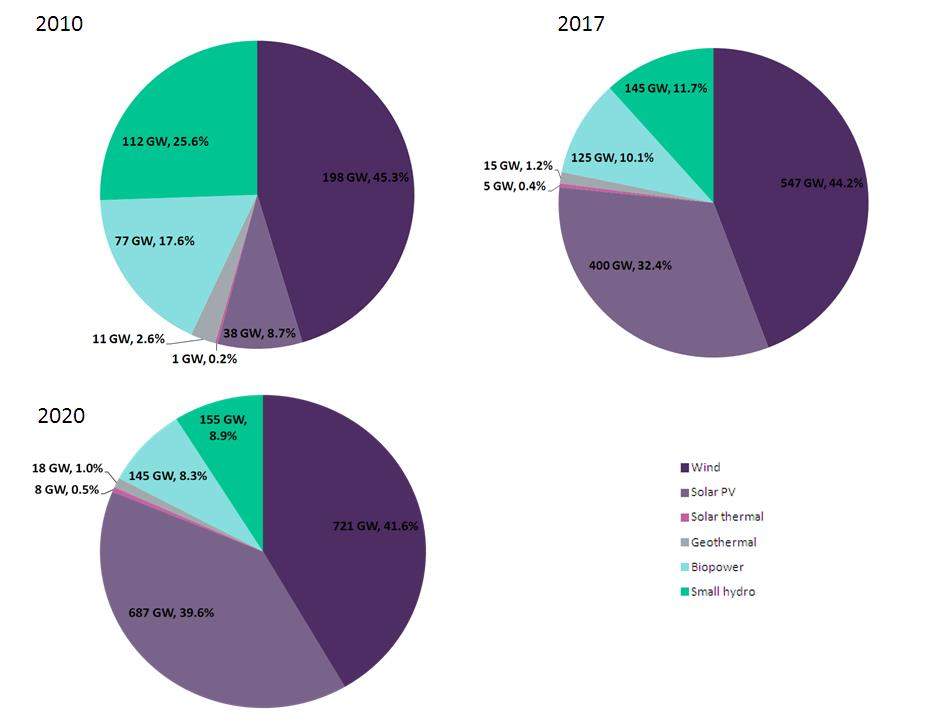The global power sector is witnessing a gradual transition from conventional thermal power-generating sources toward clean energy technologies. The ambitious renewable energy targets set by countries across the globe points toward the growing share of renewables in the global energy mix in the next 20 years. The renewables share was 8.6% in the global energy mix in 2010 and is expected to increase to 22.5% in 2020 as per a recent thematic research report Renewable Energy by GlobalData.
As changing geopolitical interests in the Middle East change the oil and gas supply markets, renewable energy is turning out to be a bright area in the global energy economy. In the past couple of years, renewable market growth rates were higher when compared with conventional fuel market rates due to the rise in penetration of renewable energy and development of this market.
“The growth of renewable power has gained momentum in the past decade in various countries, helped by a supportive policy and regulatory framework, the reduced cost of renewable electricity generation attained due to technological advances, rising electricity demand, energy security, and environmental concerns,” says GlobalData analyst Sneha Susan. “Renewable energy is being utilised in power generation, transport, rural/off-grid power, and heating and cooling.”
Global cumulative installed renewable power capacity was 1,236 gigawatts (GW) in 2017. Renewable power installations in developing markets witnessed a significant growth in comparison with the developed markets of North America and Europe.
The total installed capacity of renewable energy sources was 437GW in 2010, with a share of 8.6% in the total global installed capacity. It grew more than 2.5x to 1,236GW in 2017 and had an installed capacity share of 18.2%. Wind power was the largest renewable source with a share of 44.2% of the global renewable power capacity in 2017 followed by solar PV (32.4%), small hydro (11.7%), and biopower (10.1%).
The figure below shows the cumulative installed renewable capacity share by power-generating source in 2010, 2017, and 2020, highlighting the largest contribution from renewable energy sources such as wind and solar power.

US Tariffs are shifting - will you react or anticipate?
Don’t let policy changes catch you off guard. Stay proactive with real-time data and expert analysis.
By GlobalDataFigure: Renewable power market, global, installed capacity share by power-generating source (%), 2010, 2017, 2020

Susan continues, “Electricity produced from renewables has thus far been expensive compared to electricity produced from conventional sources and so government support in terms of incentives and subsidies plays a crucial role in sustaining renewable development. Following technological advances, wind and solar are becoming increasingly attractive in terms of costs. Onshore wind technology has evolved into an established and mature technology with a low cost of generation. Renewable projects are now starting to compete on costs rather than subsidy support, so it is expected that renewable power will become a lucrative and competitive source of electricity generation in a number of countries during the coming years.”
Wind and solar PV technologies will continue their growth trajectory as generation costs involved with these sources are becoming more competitive, thereby encouraging more projects to be set up in the coming years. The emergence of newer markets will further drive uptake for wind and solar energy sources.
Initially, governments sought to encourage solar and wind installations through FiT schemes. The decrease in costs has made it possible for these schemes to be replaced by reverse bidding mechanisms, leading to a boom in the construction of utility-scale power projects. Such booms have been more evident in the Asia-Pacific region in countries such as China and India and in South American countries such as Brazil and Chile.
“China and India have been the key drivers in development of renewable energy, especially wind and solar PV,” says Susan. “Latin America is sufficiently self-assured to take on a crucial role in climate change and renewable power development. The rapid growth of renewables across the Latin American region has boosted its efforts achieving a low-carbon economy. Technological innovations have led to increased efficiency and decreased costs, thus fostering grid competitiveness of renewables. In countries such as Brazil, Chile, Mexico, and Argentina, solar and wind power are outperforming fossil fuels.”





